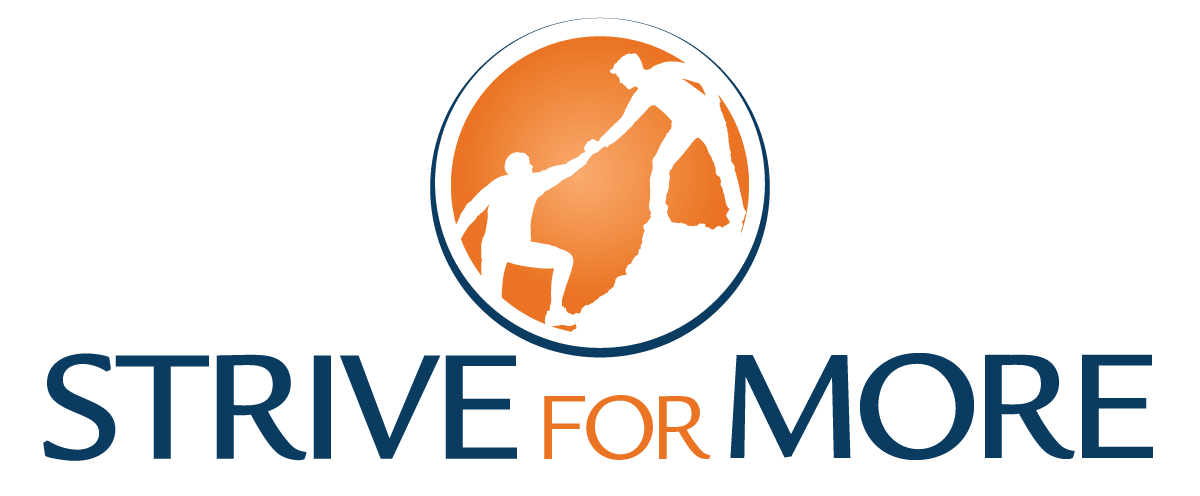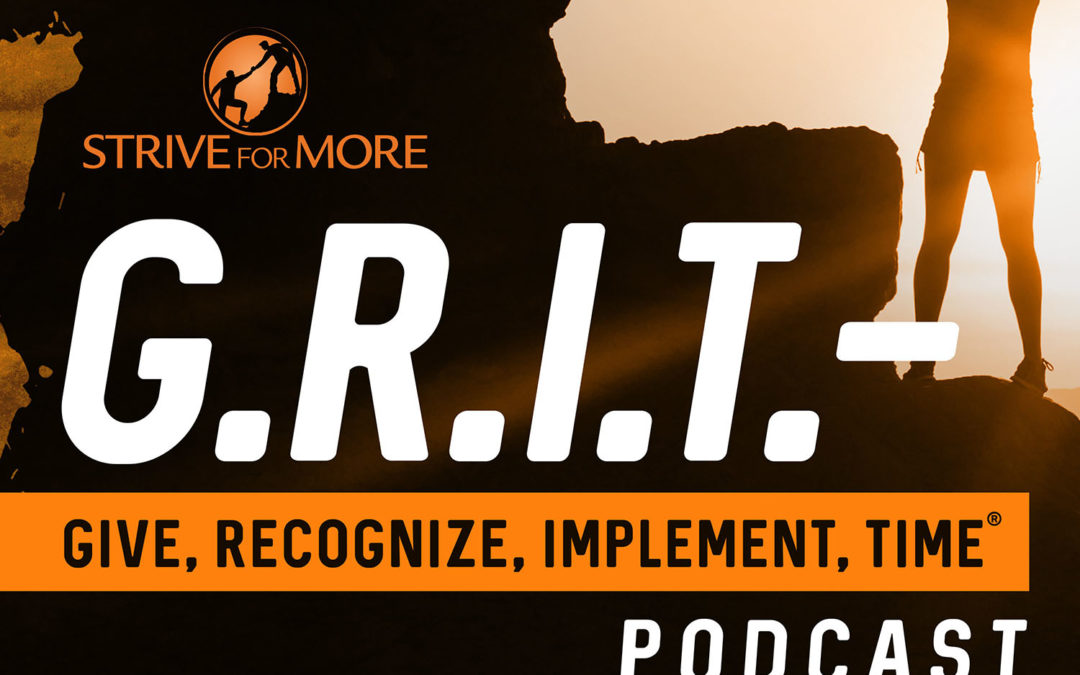Episode Transcript
Welcome back everybody to another episode of the G.R.I.T. – Give, Recognize, Implement, Time® Podcast. I’m your host, Steven Nathenson, CEO and Founder of Strive For More. Today, I want to talk about a subject that’s been at the top of mind for a lot of the clients that I’ve been working with. And that is how do I deal with poor managers? That’s a great question for us organizationally as well. When we look at employee performance, is it truly the employee or is it the manager? It’s a great conversation to have because a lot of times we’ve put more emphasis on it’s the employee, and they need to shape up, they need to get better, they need to adjust how they’re working, and they need to rise to the level of expectation.
Sometimes, and more often than not, unfortunately, we don’t look at what’s the cause of that? Is it the manager? That’s the question we’re going to tackle today, and that’s the first key to actually looking at this is when we look at employees across the board and conflict that happens in organizations, we also have to look at is it the manager? What’s driving that? That’s something that’s not done all that often because there’s a lot of truth to this statement. People quit people. When we look at the cost of turnover, the cost of disengagement, those two numbers, they’re 33 and 34% of an annual salary. That’s the estimate for how much a disengaged employee is costing us and how much turnover costs us. It’s between those two figures.
That’s a lot of money, especially, when you say have $100,000 of an employee. Even $70,000, even $50,000. When we talk about the salaries and the actual financial impact, it becomes critical to explore what’s that root cause? Because if I’m constantly losing people in a specific business unit under a specific manager, there may be a common threat there. That’s the very first key to dealing with poor managers is understanding is it truly the employee or is it truly the manager? When we explore this, it’s important to not single out individual employees. It’s important to understand the totality of the conflict that’s existing. It should be an objective exploration. A lot of times in organizations, we put emphasis on what the leaders say or the managers say.
That’s very true for, say, skip level or additional levels up the chain because all they’re getting is what the manager is saying and feeding to them. They don’t necessarily have day to day interactions with the employee in question. We don’t have firsthand knowledge, if you will. What we’re getting is hearsay, it’s secondhand information. Things that are related to us, but we don’t have physical eye witness around. This is another key for us to explore when we talk about poor managers. What is truly going on? What has been told to me by sources? What have I actually seen? Am I giving equal opportunity to all sides to truly and objectively explore and understand what is going on?
When we fail to do this, we disengage good employees, we lose people, and we create a cascading waterfall effect that we’ve seen throughout this great resignation where people are quitting people. We put more work on the people who are remaining and then we burn them out even more so than where they are currently and they end up leaving. It’s very imperative for us to explore this topic because it can have drastic financial costs on our organizations if we fail to do this. As we look at the remedies for this, I’ll repeat kind of the first steps is looking at managers, in addition to employees. Understanding the totality of it and objectively exploring what’s going on to be able to target, pinpointedly, is there something that’s truly going on with an employee? And we do need to put them on a performance movement plan and help them along and give them that opportunity to grow and develop into where we expect them to be, or is it on the managerial side?
Have they actually clearly outlined their expectations? Some of the most common things in organizations that are not expressed but are believed to have been expressed, our roles, responsibilities and expectations. I do see this time and time again. We may think we’ve clearly expressed what we expect of other people and the level at which we want them to perform, but they may have no idea. They may not have clearly understood what’s been explained. It may not be even written down or we may presume because they’re at a certain level in their career, they should meet certain expectations. In that case, have we actually conveyed what’s expected to them? Have we shared that with them? These are the good questions that can start breaking apart, where is that true disconnect?
Because as a leader, I say someone’s got five years of experience, here’s the level that I expect them to be but this is an internal dialogue that I’m having with myself. And I never convey that to somebody and they’re falling short of it. Who’s that on? We like to put that on the employee, but in reality, that’s on me as the leader for failing to clearly express what is actually expected and how someone can meet that? As we look objectively at all parties, we can then pinpoint where these development opportunities truly land. Now let’s break open a more aggressive scenario.
A lot of times we can face abrasive, belittling leaders, and this is an extreme case, but this has happened in the industry. CEO of Uber, the prior one, great example of this. What kind of culture are they creating? What’s that impact? Again, we talked about financial costs of impact of disengaging and losing employees. If you have constant turnover and loss of that say tribal knowledge, that impact’s going to be even greater. As we look at poor managers, what is that benefit to rectifying? Because if I can, as an organization, lose one manager but save 10 employees, I’m going to come out on top. In this extreme scenario, we have to look at that cultural impact that leader and manager is having as well. Because that single person can impact, not only say 10 people, if that’s the size of their team, but also on the same level and their peers.
That’s another factor that does come into play when we talk about dealing with poor managers. What is the totality of their impact on the organization? Is it positive in uplifting? Is it negative and draining? Throughout our careers, we have all likely experienced working with an individual that drains energy from people, that brings us down, and this really leads us to one of these critical components that I think is very important for organizations, which is quick to fire, slow to hire. I don’t mean that we have to instantaneously let people go, but if we’re facing a scenario of this nature where we have someone who is a true detrimental impact at a leader in managerial level in our organization, that one individual, if we objectively look at what’s going on and see that they’re causing this downward spiral and this drain of energy, that recognition and taking action on it sooner rather than later is going to have such a great impact on your organization.
And bring it up, alleviate that stress and that tension that exists from one person that will help you get to where you want to go in the future and continue to grow and develop the employees that want to be a part of that culture. So that’s what I mean by quick to fire. When we hire folks, we not only should look at the qualities of what they can do in terms of roles and responsibilities, but do they fit the culture of our organization and the leadership style, the management style that we want to employ? That we hold truth. These questions can help us over a slow hiring process vet that out to be able to ensure we’re going to avoid this kind of scenario.
I’ll recap very briefly. When we talk about poor managers, the first thing we need to understand is where does the issue truly lie? Is it with employees or is it with managers? What’s at the heart of that? Is it a lack of a vision and clear direction? Am I not giving my folks what they need to go forth and prosper? Have I perhaps not shared my expectations of what I want them to meet? Am I belittling them? Am I aggressive and yelling at them? Am I say unprofessional? These are all things to understand about the manager as well as the employee to see what that totality and the circumstances are. Because there again is a lot of truth to people quit people. Once we’ve identified what’s truly at the heart of our poor manager, we can then implement a development strategy to help them grow.
Education, coaching, or if it’s extreme, the last thing we were talking about which is quick to fire and slow to hire. Managers are not immune to being put on performance improvement plans, nor should they be because they have a large looming impact, not only in those that they lead, but the people at the peer level and even upwards for their leads as well. As we explore how to deal with poor managers, those are the critical keys. Truly look at the managers themselves, not just at the employees, understand the totality of the circumstances, the heart at the root cause of the issues that we’re seeing. Understanding what development opportunities are available to us, and if it’s worth it because it may not be. That’s when that last point again comes into play.
I hope you enjoyed today’s episode. I’m here for any questions that you may have. One thing that I’ll leave you with is as we are going through the great resignation, more now than ever, is this imperative because people do quit people. I’ve worked with a lot of clients who’ve got conflicts with their managers and they are not feeling like they’re given a fair shake. And there are two sides to every story, which is very true, and that objective exploration helps us understand for both our employees and our managers where the true issue lies and then be able to take the right appropriate action for it. So until the next time, be the movement in your life.
Listen to all of our episodes here.
Learn More About How We Help You Harness Your Resilience Through G.R.I.T. – Give, Recognize, Implement, Time®& Find More Actions You Can Take Right NOW!
To learn more about our signature coaching approach which DOES help people all over the world stay focused, overcome, and achieve, please click here.
Want to Assess Your G.R.I.T. – Give, Recognize, Implement, Time® & get a tangible gauge of key human characteristics that WILL make you successful?
Take our G.R.I.T. – Give, Recognize, Implement, Time assessment now and find out!

